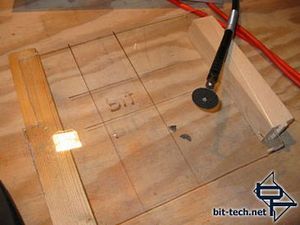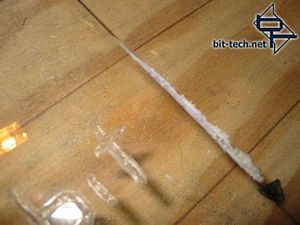

You can cut plexi/acrylic with the dremel as well. It may not be the tool of choice for this media but sometimes your in a pinch and it may be the only tool you have available. All the basic principles in cutting with the dremel are at play here but there is one new consideration with plexiglas. Because plexi melts at such a low temperature, you need to set your cutting speed low, low, low. The rule of thumb is if your bored cutting it this way, your on the right track. I opted for the flexshaft and the only cutting wheel worth using for any job, the reinforced #426. I have a scrap piece of plexi here that I used my cone-shaped grinding stone to etch a quick design into the plexi. Etching is a whole other article, mainly because this was my first crack at it and I\'m not too good yet.

This time you want to cut on the outside of your line because we are cutting out a pane instead of cutting out a hole. This is an example of what happens when you cut with the speed too high. The plexi melts and then cools creating a bunch of nasty plexi-crumbs. If the accumulate too much, you\'ll find yourself having to cut again the debris that has resolidified and glued your groove shut.

Now, if we sloooow the dremel down, we can cut a nice slow groove, I cut the one across the top so you could compare the results. Much nicer. This is slow but with much nicer results. You could almost check your watch while doing this but don\'t because you\'ve got a spinning wheel of destruction in one hand!

With it cut out, there\'s no place for any grinding stone here, you need a nice straight edge. I just rubbed each side on my sanding block to clean it up. Even on the crumby side, it cleans up nice. But the clean/slow cut sides took much less work to clean up.
There we have it. If you choose your tool carefully, you can get good results with minimal investment. With safe precautions both on your body and the piece you\'re working on, you will be assured excellent results.

MSI MPG Velox 100R Chassis Review
October 14 2021 | 15:04








Want to comment? Please log in.